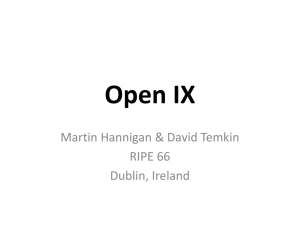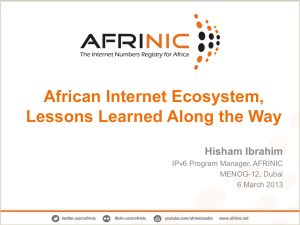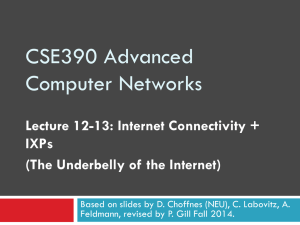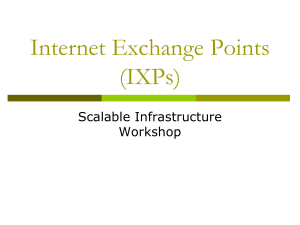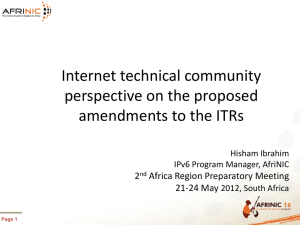Consultation on Internet Exchange Point (IXP)
advertisement
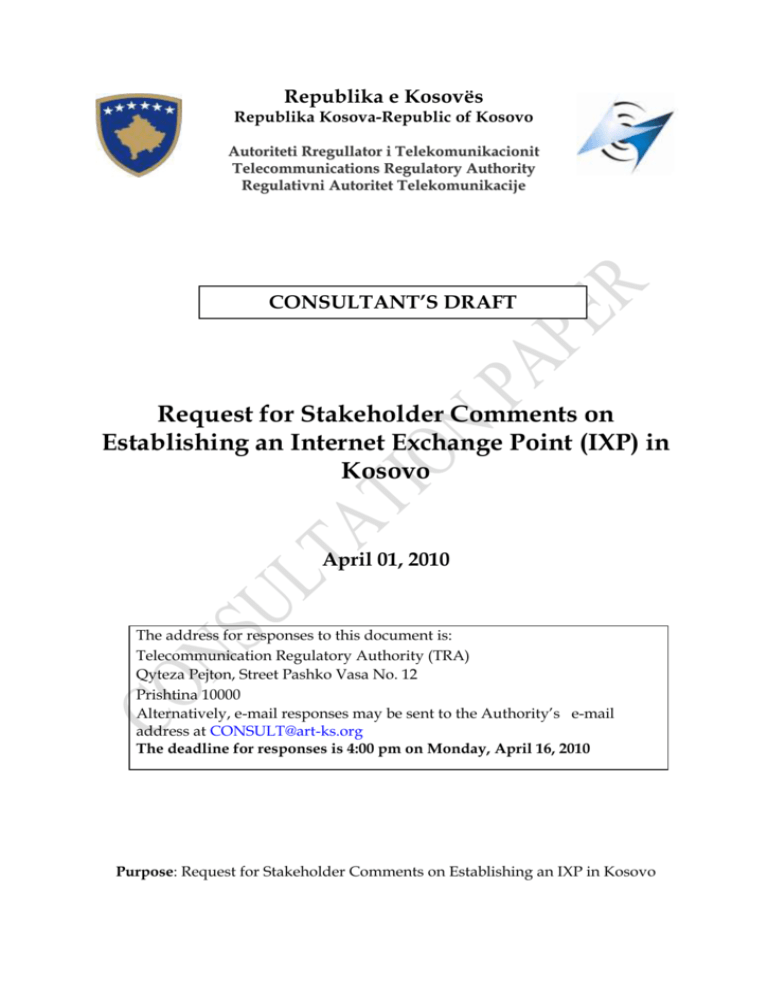
Republika e Kosovës Republika Kosova-Republic of Kosovo Autoriteti Rregullator i Telekomunikacionit Telecommunications Regulatory Authority Regulativni Autoritet Telekomunikacije CONSULTANT’S DRAFT Request for Stakeholder Comments on Establishing an Internet Exchange Point (IXP) in Kosovo April 01, 2010 The address for responses to this document is: Telecommunication Regulatory Authority (TRA) Qyteza Pejton, Street Pashko Vasa No. 12 Prishtina 10000 Alternatively, e-mail responses may be sent to the Authority’s e-mail address at CONSULT@art-ks.org The deadline for responses is 4:00 pm on Monday, April 16, 2010 Purpose: Request for Stakeholder Comments on Establishing an IXP in Kosovo Request for Stakeholder Comments on Establishing an IXP in Kosovo Table of Contents 1. 2. Introduction ................................................................................................................................. 3 1.1 Background .......................................................................................................................... 3 1.2 Scope of this Request for Comments .............................................................................. 4 Request for Comments............................................................................................................... 5 2.1 General Questions .............................................................................................................. 5 2.2 Organizational Questions ................................................................................................. 6 2.3 Technical Questions ........................................................................................................... 8 2.4 Financial Questions ............................................................................................................ 9 2.5 Peering Questions ............................................................................................................. 11 Appendix 1. Glossary of Terms ..................................................................................................... 12 Appendix 2. References................................................................................................................... 15 2 Request for Stakeholder Comments on Establishing an IXP in Kosovo 1. Introduction 1.1 Background The Internet is an essential tool for communication, commerce, and development of a “knowledge-based” society in today’s globalized world. A strong ICT sector is particularly important to Kosovo’s future growth and development. Development of Kosovo’s ICT sector depends on the ability of the national Internet infrastructure to provide reliable and affordable access to high quality broadband capacity. An IXP is a key component of a country’s Internet infrastructure that can help to increase the affordability and quality of Internet services. At present all Internet traffic transmitted between Kosovo ISPs must enter the Internet cloud using international transit links to other countries. These include links to Serbia, Macedonia, and Albania, among others. An IXP is a simple, resourceefficient means of achieving interconnection among ISPs. It keeps local Internet traffic “local,” by enabling ISPs to exchange local Internet traffic directly instead of using international links. In other markets, an IXP has been shown to have a number of benefits: Cost – Direct traffic exchange lowers an ISP's average per-bit delivery cost of service; Technical Quality – Direct traffic exchange makes a faster and more direct route from one local Internet location to another, reducing latency and other technical quality defects; Security and Privacy – Keeping local traffic “local” within national boundaries reduces privacy and security risks inherent in sending sensitive data across national borders over multiple hops; Resiliency – An IXP facilitates establishment of routing arrangements among ISPs to reduce congestion and provide redundant back-up paths in the event of upstream network outages; Response and Restoration – An IXP also helps coordinate local security (e.g., intrusion detection), infrastructure protection, and emergency response activities (e.g., CERT); Market Development – An IXP can promote local ICT service market development for co-location services (e.g., hosting, cached services, etc.) and services that require high bandwidth and low latency (e.g., real-time and multimedia services); and Services to ISPs – An IXP can provide services to its members (e.g., traffic reporting) Community – An IXP can provide a nexus for education and research projects that help develop the local Internet community and advance the ICT market. The 2007 Telecommunications Sector Policy of the Government of Kosovo, as approved and adopted by Government Decision No. 02/255 of June 13, 2007 (the Sector Policy), directs the TRA at the earliest possible date to take the necessary initiatives for the creation of an Internet Exchange Point (IXP) in Kosovo (see Sector 3 Request for Stakeholder Comments on Establishing an IXP in Kosovo Policy, §§ 3.1.3.a2, 3.1.3.a3, and 3.6.3.b) and to coordinate its efforts with the policies of Government and the Ministry of Transport and Communications (MTC) (section 3.6.1.d). Government, through the Ministry, initially represented to the European Commission that an IXP would be established in Kosovo by 2009. Completion of an Internet Exchange Point by the end of calendar 2010 is part of the TRA’s 2010 Annual Work Plan approved by Parliament. Accordingly, the TRA has determined that an Internet Exchange Point should be established in Kosovo by the end of 2010. The Authority believes this may be a regional opportunity for Kosovo since in the region only Bulgaria, Croatia, Hungary, and Slovenia have established IXPs. See table, below: Structure of Existing IXPs in SEE Country IXP Structure Bulgaria BIX.BG (Bulgarian Internet eXchange) Operator-neutral commercial and for-profit company (BIX.BG Ltd.) Croatia CIX (Croatian Internet eXchange) Non-profit service operated by University Computing Centre of the University of Zagreb; open to all: i) ISPs, ii) non-commercial networks that provide ISP services, and iii) private networks that provide ISP services in Croatia; founding members: AT&T Global Network Services Croatia, Croatian Academic and Research Network (CARNet), Croatian Radio and Television, Croatian Telecom, ISKON Internet and VIP-NET GSM Hungary BIX (Budapest Internet eXchange) Sponsored by the Council of Hungarian Internet Service Providers (Internet Szolgáltatók Tanácsa or ISzT), a nonprofit industry associations of ISPs Slovenia SIX (Slovenian Internet Exchange) Non-profit service managed by the Academic and Research Network of Slovenia (ARNES), a public academic institute with a Board appointed by government; open to all licensed ISPs and registered Internet content providers in Slovenia Albania No IXP Serbia No IXP Macedonia No IXP Bosnia No IXP 1.2 Scope of this Request for Comments A key TRA role under section 4.1 of the 2002 Telecommunications Law, as amended, is to implement the national telecommunications sector policy establishment by the 4 Request for Stakeholder Comments on Establishing an IXP in Kosovo Government.1 Additionally, this document is based on section 10; paragraph (1) of the Telecommunications Law. A stakeholder meeting, to which all the Internet Service Providers licensed by the TRA to establish international links in Kosovo were invited, was held by the TRA at its offices on Tuesday, March 2, 2010. Further to that meeting, and in fulfillment of its consultative obligations, the TRA has adopted and hereby has issued this Request for Stakeholder Comments on Establishing an Internet Exchange Point (IXP) in Kosovo. The TRA invites comments from all interested stakeholders on the following questions, the answers to which will help the Authority identify and refine the relevant policy and regulatory issues that must be addressed to establish an IXP. The contents of individual submissions will be held in confidence but the answers may be summarized and included by the TRA in other publications. Please see the notes following Questions 3.1.1 and 3.1.2. 2. Request for Comments 2.1 General Questions 2.1.1 Please estimate in Mbps the total Internet traffic that your company carried in calendar 2009 and what portion (reported in Mbps or as a percentage) of that traffic was intra-Kosovo traffic (i.e., where the originator and recipient of the message were located at Internet locations within Kosovo). [N.B. – Please be aware that the TRA will not publicly report individual answers to this question but will compile this data for the entire market and release or disclose it only in the aggregate.] 2.1.2 With respect to the international links maintained by your company, please identify the: (a) Destination countries, (b) Technology employed, (c) Installed capacity, and (d) Capacity in use. 2.1.3 Describe any potential economic, technical, security or other benefits to your company that you foresee will happen when you connect to an IXP? 1 The Law on Telecommunications adopted by the Assembly of Kosovo on December 10, 2002, (the “Telecommunications Law”) regulates the communications sector in Kosovo. The Law entered into force with UNMIK Regulation No. 2003/16 promulgated by the Special Representative of the Secretary General (SRSG) in May 2003. This Law established the Telecommunications Regulatory Authority (the ‘’TRA’’) which has responsibility for the regulation of the telecommunications sector of Kosovo, during its transition from a monopoly supplied utility to a competitive industry. On June 13, 2008, the Assembly adopted a set of amendments to the Telecommunications Law removing all references to UNMIK, clarifying certain institutional aspects and strengthening the independence of the NRA. 5 Request for Stakeholder Comments on Establishing an IXP in Kosovo 2.1.4 Describe any potential economic, technical, security or other benefits or costs that you foresee that an IXP could bring for the Internet market and broader ICT sector in Kosovo. 2.1.5 What potential risks are there with the creation of an IXP? 2.1.6 Describe the preferred circumstances and conditions under which your company would participate in an IXP. 2.1.7 Should the TRA mandate that ISPs be required to participate in the IXP? If not, why not? 2.1.8 If so, should the mandate apply to: 2.2 (a) All ISPs; (b) All ISPs licensed to establish international links; (c) All ISPs that have established international links? Organizational Questions There are a variety of institutional models that have been adopted to create and operate IXPs worldwide.2 These include: Nonprofit industry associations of ISPs University or academic institutes Government bodies (e.g., regulator) Operator-neutral commercial for-profit companies 2.2.1 In your view, what is the optimal organizational model for the establishment of an IXP in Kosovo? 2.2.2 Why? 2.2.3 With respect to the entity that would manage and operate an IXP in Kosovo: (a) What type of entity is most appropriate to manage and operate an IXP in Kosovo; (such may be government, association, university (public or private), or private company) (b) Do you have a recommendation for an appropriate candidate entity? (c) If so, please explain the basis for this recommendation. 2.2.4 Do you believe that the TRA by rule or regulation should set the basic principles and minimum requirements for the structure and operation of an IXP? 2.2.5 Do you agree that an IXP in Kosovo should function based upon the basic principles listed below: (a) Inclusive (open to all qualifying ISPs)? 2 The nonprofit ISP industry association and the academic institute are the models most commonly employed in Europe. Operator-neutral commercial for-profit companies are prevalent in the United States. 6 Request for Stakeholder Comments on Establishing an IXP in Kosovo (b) Technically reliable? (c) Operator neutral (not a competitor in the market for retail Internet services)? (d) Based on agreed-upon, open standards (e) ISP users participate in governance? If you answer to the question is “no” for any of the bulleted items above, why not? 2.2.6 Do you believe there are additional basic principles to those listed in 3.2.5 that should be included? If you do, what are they? 2.2.7 What eligibility criteria should be established for ISP participation in an IXP, and why? 2.2.8 Should the IXP web site be public or for ISP members-only? 2.2.9 With respect to the operating policies of an IXP: (a) Should interconnection rules to define the terms and conditions under which an ISP is permitted to route their Internet traffic to another ISP's network via the IXP be set: by the IXP by the ISPs per bilateral agreements by the TRA (b) Should routing control over the traffic to the IXP be performed by IXP or by ISPs (or both)? (c) Should transit traffic (e.g., ) be permitted through the IXP and, if so, under what terms and conditions? (d) Should an IXP be limited exclusively to capturing only the content of a member’s data traffic that is required for the conduct of traffic analysis and control? (e) What additional confidentiality rules should apply to the IXP? (f) Should the IXP collect and report technical information to members? If so, what type (e.g., ASN paths, looking-glass sites)? (g) What types of technical information collected by the IXP should be reported to the TRA? (h) Should any, and if so what types, of technical information collected by the IXP should be made publicly available? (i) What should traffic filtering policies be for the IXP? (j) Who should set those policies? (e.g. TRA, IXP, ISPs, other?) 7 Request for Stakeholder Comments on Establishing an IXP in Kosovo (k) What should the IXP role be in the event of security problems, infrastructure failures, routing equipment failures, or software configuration mistakes? (l) What additional security response services should the IXP provide to the ISP participants? (m) What limitations of liability should there be for IXP operations? 2.3 (n) What are appropriate access rules for ISP member staff access to the IXP premises, if any? (o) What additional technical support services should the IXP provide to the ISP participants? Technical Questions 2.3.1 What technical model should be used – (a) Layer 3, in which ISP members exchange traffic inside the router located on the IXP, or (b) Layer 2, in which IXP provides switching connectivity and ISP members retain full control over routing policy? Please state the reasons for your answer. 2.3.2 What protocols should be used (e.g., BGP, other)? 3.3.3 Should the IXP be connected to the Internet other than through its ISP members? 2.3.4 What should be the content of the Internet Routing Registry (IRR) set up at the IXP? 2.3.5 What are the optimal means of establishing physical connectivity between IXP and each ISP? Fibre, wireless, etc. Existing ISP platforms or new facilities 2.3.6 Are there any circumstances where bandwidth and/or download restrictions should be imposed on ISP participation in an IXP? 2.3.7 Should a minimum bandwidth be required for ISP links to the IXP? 2.3.8 Should the IXP be required to provide redundancy and increased fault tolerance (e.g., each ISP connects to a single switch/router or, to provide fault tolerance, to multiple switches/routers located at IXP)? 2.3.9 Should the IXP be required to implement a denial of service (DOS) attack detection system at the IXP switch(es)/router(s)? 2.3.10 For IXP address space, should the IXP obtain separate address space (e.g., /24 network) or use address space from an existing ISP(s)? 8 Request for Stakeholder Comments on Establishing an IXP in Kosovo 2.3.11 What are the key required elements and their specifications for physical security of the IXP space? 24h CCTV, Locks, Controlled access for IPX members, Space requirements for cabling, racks and equipments, Fire control, Air-conditioning, Power supply/backup, Other (please specify). 2.3.12 Should a time server or other services for ISPs be provided by the IXP (please specify)? 2.4 Financial Questions 2.4.1 Based on your understanding of the intra-Kosovo traffic volumes generated by Kosovo ISPs, do you believe an IXP would lead to a cost savings, increased cost, or be cost neutral for your company? (Please specify the basis for your answer in financial figures.) 2.4.2 Do you believe that at present there is a market in Kosovo for more than one IXP? 2.4.3 Based on your previous answers, please estimate the capital costs required to establish an IXP? a. Cost of equipment for the core of the IXP (refer to section 3.3) b. Preparing the space c. Furnishing the space: d. e. i. Backup power, ii. Air-conditioning, iii. Equipment cabinets, and iv. Relevant security fixtures. Link provision from ISP to IXP i. Router, ii. Fiber or other link. Other (please specify) 2.4.4 How many staff do you estimate the IXP will require? 9 Request for Stakeholder Comments on Establishing an IXP in Kosovo 2.4.5 Would your company consider providing technical advice and assistance to the IXP at no cost? 2.4.6 Based on your previous answers and your understanding of your own operations, please estimate the costs for annual IXP operations: a. rent of space, b. electricity, c. staff salaries (how many?) d. security, and e. insurance costs 2.4.7 How should the financing of IXP CAPEX requirements be arranged? a. In the case of an academic institution or institute: i. A PPP option using a mix of grant and Government funds? ii. A PPP option using a mix of grant and Government funds, plus ISP contributions? iii. Wholly subsidized by Government? b. In the case of a private sector association, private capital plus a partial subsidy? c. A private, for-profit company using its own capital? 2.4.8 Under what circumstances would your company contribute to funding the capital costs of establishing an IXP under the options described in 3.4.6(a) and (b)? 2.4.9 How should the financing of IXP OPEX requirements be arranged? Please specify a. OPEX recovered based on a monthly, cost-based, per capita subscription fee for all ISPs connecting to IXP? b. OPEX recovered based on a monthly, cost-based, subscription fee apportioned among ISP members based on relative traffic volumes of each ISP connecting to IXP? c. OPEX recovered based on a combination of a monthly flat, cost-based, per capita subscription fee for all ISPs connecting to IXP, plus an additional fee to be based on relative traffic volumes of each ISP? d. OPEX costs for a maximum initial period of two years from start-up to be publicly subsidized, and then reverting to one of the options described above? e. Other? 2.4.10 Should “in-kind” contributions by ISPs be permitted as a substitute for fees and, if so, under what circumstances? 10 Request for Stakeholder Comments on Establishing an IXP in Kosovo 2.4.11 While payment for the cost and maintenance of the link between the ISP network and the IXP (including a redundant link if required) is usually the responsibility of each ISP member, some IXPs have adopted policies to smooth these costs so that each member pays the same amount to access the IXP. Should TRA consider requiring this approach for the Kosovo IXP? 2.4.12 Does the future potential exist for the IXP to serve as a sales point for the provision by Tier 1 ISPs of connectivity to smaller ISPs? If not, why not? Should such activity be prohibited or restricted? 2.5 Peering Questions 2.5.1 Should all ISPs that connect to the IXP be required to peer with every other connected ISP? 2.5.2 What are appropriate peering rules for the IXP? Should all ISPs connected to the IXP be required to peer with every other connected ISP: (a) Under a Mandatory Multilateral Peering Agreement (MMLPA) to be established by the IXP with TRA approval? (b) Under Bilateral Peering (BLP) arrangements, the commercial terms of which the ISPs would be free to negotiate, provided they are completed within a set time period? (c) Under Bilateral Peering (BLP) arrangements, where the minimum basic commercial parameters required for peering arrangements are set by the TRA by rule or regulation and the actual negotiation is lefty to negotiations between ISPs? Please explain the reasons for your answer. 2.5.3 Where there are significant asymmetries (please specify a qualifying asymmetry in terms of traffic ratio or other measure) between potential peering partners should “paid peering” arrangements be an option? 2.5.4 If so, under what conditions would paid peering be an appropriate approach? 11 Request for Stakeholder Comments on Establishing an IXP in Kosovo Appendix 1. Term Autonomous system number Glossary of Terms Acrony m ASN Backbone Border Gateway Protocol Definition Unique ASNs are allocated to Internet operators by the regional internet registries (RIRs) for use in multipath routing. An ASN is only issued when an institution demonstrates the means to maintain an independent routing policy. This entails having direct interconnections with at least two other, similarly independent external network entities. In the widest sense, an autonomous system is a connected group of one or more IP prefixes run by one or more network operators, with a single and clearly defined routing policy. The trunk routes of a network used as the path for transporting traffic between different networks. Backbones can be the physical telecommunication infrastructure or the Internet circuits established over them by a particular Internet operator. BGP A protocol for exchanging routing information between gateway hosts (each with its own router) in a network of autonomous systems. The routing table contains a list of known routers, the addresses they can reach, and a cost metric associated with the path to each router so that the best available route is chosen. Bits per second bps The number of bits passing a point every second. The transmission rate for digital information, that is, a measure of how fast data can be sent or received. Often expressed for broadband links as Megabits per second (Mbps), where a Megabit equals one million bits, or Gigabits per second (Gbps), where a Gigabit equals one billion bits. Broadband A high-speed data connection. Connection redundancy Two or more physically separate connections via different network providers. Redundancy ensures continued links to the Internet in the event of one connection going down. Dark fibre The maintenance of optical fibre transmission capacity between customer locations in which the light for the fibre is provided by the customer rather than the provider of the fibre optic cable. Fibre optic cable A technology using glass fibre for the transmission of data. A signal is imposed on the fibre via pulses (modulation) of light from a laser or light-emitting diode (LED). Because of its high bandwidth and lack of susceptibility to interference, fibre optic cable is used in high-capacity long-haul or noisy applications. Hop An intermediate connection in a string of connections linking two network devices on the Internet. Each time a data packet is forwarded to the next router, a hop occurs. The more hops, the more latency, i.e., the number of milliseconds it will take for a packet of data to go from source to destination. 12 Request for Stakeholder Comments on Establishing an IXP in Kosovo Interconnectio n Any direct connection between two networks—private or commercially operated Internet-based networks or telecom networks of fixed or mobile operators. Cost of interconnection is usually incurred by the parties on either end of the connection. International gateway Technically, a facility to consolidate and share the cost of international links. Internet A global mesh of computer networks using TCP/IP. The Internet’s national and international backbones are high-speed, fibre trunk lines owned by telecommunication companies. National Tier-1 service providers aggregate data traffic and pass it over the backbones and work with local service providers, who connect to customers via digital links or modems. Internet routing registry IRR A globally distributed routing information database that ensures stability and consistency of Internet-wide routing by sharing information between network operators. The IRR comprises several databases in which network operators publish their routing policies and announcements. In addition to making Internet topology visible, the IRR is used by network operators to look up peering agreements, determine optimal policies, and configure their routers. Internet service provider ISP Licensed organizations that provide Internet access services. ISPs purchase bandwidth from upstream companies, which have links to the Internet and then sell that bandwidth to consumers and businesses in smaller units. Internet exchange point IXP Also called IX, EP, NAP, or peering point. Both a physical networking location and a logical networking strategy, which facilitates interconnection between Internet-based networks. Internet network A collection of devices interconnected via TCP/IP. Networks may be commercially run by an ISP or run by an organizations for internal purposes, such as company-wide and academic networks. Latency A synonym for delay and an expression of how much time it takes for a packet of data to get from one designated point to another in a network. Leased line A telecommunications circuit usually rented from a telecom operator to connect two or more locations. Where regulations allow and the physical location of the two points to be connected makes it feasible, Internet providers may establish their own wireless, cable, or fibre link, thereby eliminating the need to lease a circuit from a third party. Looking glass A web-based connection to a router that enables administrators of other networks to see a network’s routing information. Looking-glass information may or may not be made available to the broader public. Metropolitan area network. MAN Usually a fibre-optic ring spanning a large city. 13 Request for Stakeholder Comments on Establishing an IXP in Kosovo Multilateral peering agreement. MLPA An agreement by networks connecting to an IXP to exchange data with all other networks connected to the peering point. Often mandatory when joining an IXP. Paid Peering A peering arrangement in the usual definition where router configurations, exchange point arrangements, and all peering interconnections logistics proceed as under a free peering arrangement, but where a settlement fee is paid based either on total traffic or the net traffic asymmetry, or where transport costs are apportioned asymmetrically. Paid peering is sometimes positioned as a stepping stone toward establishing free peering so that settlement fees are no longer required once prerequisites are met Peering A zero-compensation arrangement in which network operators agree to exchange traffic at no charge. Common practice where the networks in question have roughly the same characteristics and traffic volumes, meaning a net financial burden from traffic flow between them is likely to be small. The process by which a network qualifies for peering is usually privately negotiated based on market position, network coverage, volume of traffic, range of services provided, and network reliability. In general, peering only takes place when one of the two networks would not be significantly disadvantaged by termination of the link between them. Route server One or more IXP BGP route server peers that collect and redistribute IXP member routes Transmission control protocol and Internet protocol TCP/IP The two protocols that form the basis of communication across the Internet. Currently most of the Internet is based on version 4 of the IP protocol, but as the free pool of IPv4 addresses approaches capacity, there are growing calls to accelerate IPv6 deployment. Terrabit One thousand Gigabits. Transit An arrangement in which a network sells access to another network to enable its connection to a third party network. Transit charges are set by negotiation and often are not disclosed publicly. Transit arrangements typically provide access to an array of networks not limited to one country. In many cases one Internet transit arrangement with a large network can provide a small, remote network with access to the rest of the world. Virtual private VPN network An encrypted channel between two end points on the Internet that provides secure communications. 14 Request for Stakeholder Comments on Establishing an IXP in Kosovo Appendix 2. References - Mike Jensen, Promoting the Use of Internet Exchange Points: A Guide to Policy, Management and Technical Issues, Internet Society, (2007), available at www.isoc.org/educpillar/resources/docs/promote-ixp-guide.pdf. - Steve Gibbard, Economics of Peering, Packet Clearing House/Steve Gibbard Consulting (October, 2004) - Bevil M. Wooding, Benefits of Internet Exchange Points for the Caribbean, Packet Clearing House (PCH)/Caribbean Telecommunications Union (CTU) (2006) - Harry Bouwman, Heleen De Vlaam & Marieke Fijnvandraat, Internet and Interconnection Regulation: Case Studies from the USA, the UK and the Netherlands, Communications & Strategies, no. 47, 3rd quarter 2002, p. 147 (Delft University of Technology) - Organization for Economic Cooperation and Development (OECD), Internet Traffic Exchange and the Development of End-to-end International Telecommunication Competition, DSTI/ICCP/TISP(2001)5/FINAL (2002) (OECD Directorate for Science, Technology and Industry, Committee for Information, Computer and Communications Policy, Working Party on Communication Infrastructures and Services Policies) - Bill Woodcock, Good Practices in Internet Exchange Point Documentation and Measurement, OECD DSTI/ICCP/CISP(2007)9 (2007), (OECD Directorate for Science, Technology and Industry, Committee for Information, Computer and Communications Policy, Working Party on Communication Infrastructures and Services Policies), available at www.olis.oecd.org/olis/2007doc.nsf/FREREFCORPLOOK/NT00000F9A/$FILE/JT03226139. PDF - Internet Society, Briefing Paper: Internet Exchange Points (IXPs) (2008), available at www.isoc.org/educpillar/resources/docs - Mike Jensen, Interconnection Costs, Document WSIS-II/PC-3/CONTR/94-E (Association for Progressive Communications (APC) 28 September 2005) - Bill Woodcock, Tutorial on the Design and Construction of Local and Regional Exchange Facilities, Version 0.3, Packet Clearing House (March, 2001) - Steffen Lippert and Giancarlo Spagnolo, Internet Peering as a Network of Relations, Governance and the Efficiency of Economic Systems (GESY) Discussion Paper 191 (November 2006) - Sam Paltridge, Internet Access for Development, OECD Directorate for Science, Technology and Industry (DSTI), (June 2009) - Michuki Mwangi, Internet Exchange Points: Lowering Costs and Promoting Internet Development, presented at OECD Conference: Policy Coherence in the Application of ICT for Development, Paris, France (September 2009), available at www.oecd.org/dataoecd/32/15/43759912.pdf - U.S. Federal Communications Commission, Network Reliability and Interoperability Council V, Focus Group 4: Interoperability, Service Provider Interconnection for Internet Protocol Best Effort Service (2001), available at www.cybertelecom.org/broadband/backbone.htm - Interisle Consulting Group, LLC, Interconnection and Peering Among Internet Service Providers: A Historical Perspective (2005), available www.interisle.net/sub/ISP%20Interconnection.pdf - ColoSource, Internet eXchange Points, available at http://www.colosource.com/ix.asp - European Internet Exchange Association, 2009 Report on European IXPs (23 October 2009), available at www.euro-ix.net/resources/reports/euro-ix_report_2009.pdf 15 Request for Stakeholder Comments on Establishing an IXP in Kosovo - Z. Morley Mao, Lecture 5: Internet AS relationships, Routing Policy on Internet Paths (Jan 20, 2005), available at www.eecs.umich.edu/~zmao/eecs598-4/notes/Lecture5.pdf - Croatian Internet Exchange, materials at www.cix.hr/cix_o_usluzi.html?&L=1 - Slovenian Internet Exchange, materials at www.arnes.si/english/six.html - University of Zagreb, University Computing Centre, Policy of the Croatian Internet Exchange (CIX) National Centre for the Mutual Internet Traffic Exchange (2007), available at www.cix.hr/cix_o_usluzi.html?&L=1 - Bulgarian Internet Exchange (BIX), BIX.BG – Concise Company Presentation (2009), available at www.bix.bg - Budapest Internet Exchange, Charter Rules of Operation and Use of the BIX (2009), available at www.bix.hu/index.php3?lang=en&page=charter. - William B. Norton, A Business Case for ISP Peering in 2004 (2004), available at www.drpeering.net/a/Internet_Peering_White_Papers_files/ 16
